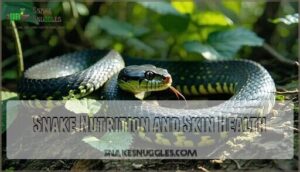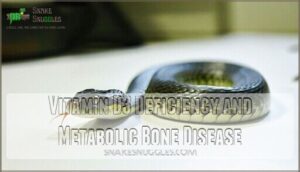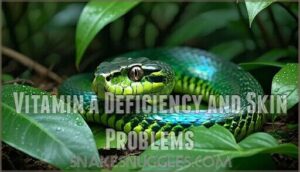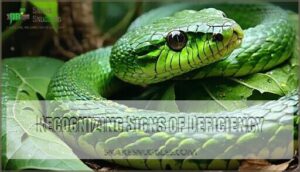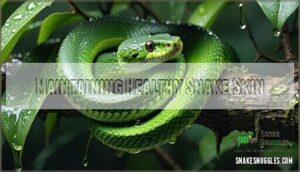This site is supported by our readers. We may earn a commission, at no cost to you, if you purchase through links.

A balanced diet rich in Vitamin A, calcium, and whole prey can support strong skin and overall health.
Don’t forget UVB lighting for Vitamin D3 synthesis.
By making informed choices, you can help prevent skin issues and metabolic bone disease.
Now, let’s get into the nitty-gritty of creating a customized diet plan that meets your snake’s unique needs, and explore how to tackle common skin problems and nutritional deficiencies.
Table Of Contents
- Key Takeaways
- Nutrients for Healthy Snake Skin
- Foods That Support Snake Skin Health
- Snake Diet for Skin Problems
- Managing Snake Skin Conditions
- Creating a Balanced Snake Diet
- Snake Nutrition and Skin Health
- Common Vitamin Deficiencies in Snakes
- Preventing Nutritional Deficiencies
- Snake Diet for Healthy Skin
- Maintaining Healthy Snake Skin
- Frequently Asked Questions (FAQs)
- Can you lose 10 pounds in 3 days liquid diet?
- Why is 16 hours the magic number for fasting?
- What is a snakes diet plan?
- What is the 4 3 diet for weight loss?
- What is a snake diet?
- Are there any foods that are generally good for our skin?
- What makes a snake healthy?
- Does the snake diet protect against health problems?
- Is the snake diet good for weight loss?
- What is a healthy snake nutrition guide?
- Conclusion
Key Takeaways
- You’ll boost your snake’s skin health with a balanced diet rich in Vitamin A, calcium, and whole prey, which supports strong skin and overall health.
- You can prevent nutritional deficiencies by providing a variety of mineral-rich prey, considering prey size and feeding frequency, and ensuring proper hydration and UVB lighting.
- You’ll want to monitor your snake’s health regularly, including weight checks, fecal examinations, and blood work, to identify any potential issues and make adjustments to their diet as needed.
- You can create a customized snake diet plan by focusing on variety, gut-loading, and supplement strategies, and by considering your snake’s age, prey size, and meal frequency to ensure they’re getting the nutrients they need for healthy skin.
Nutrients for Healthy Snake Skin
You’re about to learn how a well-planned diet can boost your snake’s skin health.
Boost your snake’s skin health with a well-planned diet
By understanding the key nutrients, such as Vitamin A, calcium, and protein, you can create a balanced diet that supports healthy, vibrant skin for your pet snake.
Importance of Vitamin a and UVB Lighting
You’re invested in your snake’s skin health.
Vitamin A benefits are key, found in prey, keeping skin vibrant.
UVB lighting aids D3 synthesis, impacting skin health.
Balance UVB exposure time to avoid deficiencies.
Proper lighting types and snake diet prevent nutritional deficiencies, ensuring healthy skin.
Vitamin A and UVB lighting are essential for your snake’s overall skin health impact, with skin health being a critical consideration.
Role of Calcium in Snake Skin Health
You prioritize calcium for strong bones and healthy skin.
Here are key points:
- Calcium absorption
- Scale formation
- Bone health
- MBD prevention
- Dietary calcium, preventing calcium deficiency with supplementation, maintaining a balanced calcium-to-phosphorus ratio in your snake’s diet.
Proper supplementation can be achieved with snake calcium products.
Trace Minerals for Healthy Scales
You’ll want to make certain your snake gets enough trace minerals for healthy scales.
Zinc importance and copper benefits can’t be overstated. Mineral absorption is key to scale integrity.
Consider supplementation options or feeding mineral-rich prey to support snake skin health.
Trace minerals can prevent scale abnormalities, promoting overall health.
Protein for Growth and Muscle Development
Now, let’s build those muscles! After trace minerals, protein is key for your snake’s growth and muscle development. Think of it as their workout fuel.
Good Protein Sources are mice and rats, which supply Amino Acids.
- Aids Muscle Repair
- Fuels Growth Stages
- Prevents muscle weakness
- Supports muscle recovery
- Boosts overall health
Ensure your snake gets enough Dietary Protein for excellent growth rates. A balanced snake diet keeps them sleek and healthy. If you don’t feed them enough protein, they won’t grow well. Remember, snake meat is muscle, and muscle needs protein.
Foods That Support Snake Skin Health
You’re looking to provide the best diet for your snake’s skin health, and it starts with choosing the right foods.
By selecting prey animals rich in Vitamin A, calcium-rich prey, and whole prey, you can help support your snake’s skin health and overall well-being.
Prey Animals Rich in Vitamin A
You often feed your snake prey rich in vitamin A, like mice and rats, to boost skin health.
| Prey | Vitamin A | Nutritional Value |
|---|---|---|
| Mice | High | Rich in protein |
| Rats | High | Rich in protein |
| Gerbils | Medium | Rich in fiber |
| Rabbits | Low | Rich in carbohydrates |
| Young Chicks | High | Rich in protein |
Calcium-Rich Prey for Healthy Bones
You feed your snake calcium-rich prey like quail for strong bones.
- Quail Nutrition
- Bone Density
- Gut Loading
- Prey Diversity
Calcium deficiency risks bone health, so balance calcium supplementation and mineral-rich prey for ideal bone density.
Foods High in Trace Minerals
As you craft a snake diet, consider trace minerals.
Mineral-rich prey, like certain rodents, can help.
You can also explore supplement options to guarantee your snake gets the right balance.
Deficiency symptoms can be subtle, so it’s vital to monitor absorption factors.
A balanced diet is key to preventing nutritional deficiencies.
Gut-loading benefits can also enhance the mineral content of prey.
By incorporating trace minerals into your snake’s diet, you’ll be supporting healthy skin and overall well-being.
This is a critical aspect of a well-rounded snake diet, essential for preventing deficiencies and promoting peak health.
Whole Prey for Balanced Nutrition
You want your snake’s skin to glow.
Whole prey boosts collagen and antioxidants, supporting healthy skin.
Consider:
- Prey Gut-loading for extra nutrients
- Whole-prey Variety for nutritional completeness
- Wild Diet Mimicry for natural balance
- Prey Size Matters for safe feeding, ensuring a balanced diet and preventing nutritional deficiencies, which is crucial for healthy skin.
Snake Diet for Skin Problems
You’re about to learn how a well-planned snake diet can help address skin problems in your pet.
By understanding the importance of nutrients like Vitamin A, Calcium, and trace minerals, you can create a diet that promotes healthy skin and overall well-being for your snake.
Vitamin a Deficiency and Skin Issues
Dealing with vitamin A deficiency in snakes can be challenging.
You’ll notice skin problems, like dull skin, and vision problems.
To tackle it, consider:
- Vitamin A-rich foods
- Consulting a reptile vet
- Supplementation
This helps prevent reproduction issues, organ damage, and immune suppression, common vitamin A deficiency symptoms.
Calcium Deficiency and Metabolic Bone Disease
You’ll want to avoid calcium deficiency, which leads to metabolic bone disease.
Make certain your snake gets enough calcium from whole prey, and consider supplementation with vitamin D3 to prevent MBD symptoms and support bone density, addressing nutritional deficiencies and promoting healthy skin.
Vitamin E Deficiency and Muscle Weakness
You notice your snake’s muscle weakness, a sign of vitamin E deficiency. This affects muscle function and skin health.
A balanced snake diet with quality prey and vitamins can prevent issues. Vitamin E plays an antioxidant role, and supplementation options are available.
Dietary sources can help alleviate muscle atrophy and neurological impact, ensuring a healthy skin boost through a well-planned snake diet with a focus on antioxidant role.
Addressing Nutritional Deficiencies
You tackle nutritional deficiencies with dietary adjustments and supplementation options.
Consider:
- Gut-loading benefits
- Deficiency symptoms
- Calcium supplementation to prevent calcium deficiency, ensuring adequate vitamin A and trace mineral supplements for healthy skin, addressing nutritional deficiencies with preventative measures, including calcium supplementation.
You should ensure that all aspects of nutritional care are considered to prevent deficiencies.
Managing Snake Skin Conditions
You’re taking the right steps to manage your snake’s skin conditions by learning about the importance of a balanced diet and proper care.
By understanding the signs of skin problems and making adjustments to their diet, you can help keep your snake’s skin healthy and thriving.
Signs of Skin Problems in Snakes
You’re checking your snake’s skin. Look for:
- Scale discoloration
- Lesions
- Shedding issues, like excessive shedding, which can signal snake skin issues, including bumpy texture and scale abnormalities, or shedding difficulties, and cloudy eyes, or skin lesions.
Regular skin inspections can help with early detection of issues, including early detection of issues, which is crucial for identifying snake skin issues and shedding difficulties.
Dietary Adjustments for Skin Health
You can adjust your snake’s diet to combat skin issues with prey diversity and supplements, focusing on hydrated prey and quality nutrition to boost skin health.
While preventing nutritional deficiencies and obesity through strategic prey gut-loading and supplement strategies is crucial, it is essential to consider the overall diet and health of the snake.
Importance of UVB Lighting
Don’t underestimate UVB lighting; it’s more than just a spotlight.
It’s essential for shiny scales.
Without proper UVB lighting, your snake could struggle with vitamin D3 synthesis and calcium absorption.
This affects reptile health.
Here’s what UVB lighting does:
- Aids shedding, reducing drama.
- Promotes reptile health.
Check snake UVB lamp options for the correct lighting spectrum.
Consider UVB lamp options for your snake.
Distance matters, as does bulb lifespan.
Think of UVB benefits as a boost for your snake diet, preventing nutritional deficiencies.
- It’s like sunshine in a box.
- It supports your snake’s vitamin D3.
Regular Veterinary Check-Ups
You play a vital role in maintaining your snake’s health.
Regular veterinary check-ups are key to preventative care, early detection, and disease prevention.
By scheduling visits, you’ll catch potential skin issues before they worsen, ensuring health monitoring and parasite prevention.
Keep health records, transport your snake safely, and communicate openly with your vet for ideal veterinary care and preventative care.
Creating a Balanced Snake Diet
You’re taking the first step to create a balanced snake diet by considering the nutritional needs of your pet.
By choosing the right prey and making seasonal adjustments, you can help boost your snake’s skin health and overall well-being.
Variety in Prey Selection
You can boost your snake’s skin health with prey diversity.
Try these tips:
- Mix prey sizes
- Gut load prey
- Embrace seasonal variation
- Rotate prey for nutritional balance, mimicking wild diets with prey variety, including mice, rats, and quail.
Nutritional Value of Different Prey Types
You’re creating a snake diet.
Mice and rats offer protein and calcium. Insects provide extra fiber.
Prey variety helps avoid deficiencies, like eczema. Whole prey, like quail, provides balanced nutrition.
Gut loading enhances nutrient content. Consider the nutritional value of prey, including mice, rats, and insects, to keep your snake healthy.
Seasonal Dietary Adjustments
You adjust your snake’s diet seasonally.
Consider:
- Winter brumation
- Summer feeding
- Breeding season
to prevent shedding problems, ensuring they get enough vitamin A and prey availability, despite temperature impact and environmental changes.
It’s also important to provide variety in prey for balanced nutrition.
Meeting Specific Nutritional Needs
You’ll tailor your snake’s diet by gut-loading prey, supplementing, and adjusting for age and breeding.
This guarantees they get the right nutrients, like vitamin A and trace minerals, to prevent deficiencies and promote healthy skin, all part of a balanced snake diet.
Snake Nutrition and Skin Health
You’re about to learn how a well-planned snake diet can boost your pet’s skin health.
By understanding the role of nutrients like Vitamin A, calcium, and trace minerals, you can create a balanced diet that supports healthy, vibrant skin for your snake.
Role of Temperature in Digestion
You control your snake’s digestion rate by setting the ideal temperature.
- Thermoregulation impact
- Enzyme activity
- Heating methods
- Environmental conditions affect snake metabolism and digestion, so adjust temperature for a healthy snake diet.
Importance of Hydration
You monitor hydration to prevent shedding issues.
Here’s how:
- Check humidity levels
- Encourage drinking habits
- Offer bathing benefits
- Balance electrolyte levels for healthy snake skin, ensuring proper hydration methods in your snake diet.
Lighting and Vitamin D3 Synthesis
You need UVB lighting for your snake’s vitamin D3 synthesis.
It’s essential for calcium absorption and skin health.
Without it, vitamin D3 deficiency can lead to calcium deficiency signs and skin problems.
Make certain proper UVB spectrum and lighting distance in the enclosure to prevent nutritional deficiencies.
Stress Factors Influencing Appetite
After ensuring proper lighting, remember that stress impacts everything, even your snake’s appetite. A stressed-out snake might show disinterest in food.
Here’s what you should know:
- Environmental Changes, like moving to a new Enclosure Size, can be stressful.
- Temperature fluctuations also cause appetite changes.
- Handling stress needs a gentle approach; consider Handling Frequency.
- Illness greatly impacts appetite.
- Inadequate Prey Availability
- Overcrowding
- Excessive noise
- Social Stressors
A vet visit is key if you notice problems. Don’t panic, but do pay attention. A healthy snake diet is essential for healthy skin, minimizing inflammation. Think of it this way: a happy snake, is a healthy snake!
Common Vitamin Deficiencies in Snakes
You’re likely aware that vitamin deficiencies can affect your snake’s skin health, and it’s essential to identify them early.
By recognizing common vitamin deficiencies, such as Vitamin D3 and Vitamin A deficiencies, you can take steps to prevent them and keep your snake’s skin healthy and thriving.
Vitamin D3 Deficiency and Metabolic Bone Disease
You notice your snake struggling, a sign of vitamin D3 deficiency, leading to metabolic bone disease.
UVB lighting and dietary calcium are essential for bone health, so consult a reptile veterinarian for prevention strategies, including D3 supplementation and balanced calcium-to-phosphorus ratio in mineral-rich prey.
Weight loss and sluggish behavior can also indicate snake nutritional deficiencies, which may require a review of the snake’s overall health and diet to prevent further issues related to metabolic bone disease.
Vitamin a Deficiency and Skin Problems
You’re tackling vitamin A deficiency, a common issue causing skin problems in snakes.
This can lead to vision impairment and appetite loss.
Consider supplementation options to prevent respiratory infections and skin issues, addressing nutritional deficiencies and vitamin A needs to keep your snake’s skin healthy and vibrant.
Recognizing Signs of Deficiency
You can spot vitamin deficiencies by watching for dull skin, shedding problems, or scale discoloration.
Lifting scales, bumpy texture, or excessive shedding are also red flags.
Prevent skin problems by addressing nutritional deficiencies, especially vitamin A, to keep your snake’s skin healthy and vibrant, preventing dull skin causes, which can be considered a red flag.
Preventing Nutritional Deficiencies
You’re taking the right steps to guarantee your snake’s skin health by learning about preventing nutritional deficiencies.
By providing a balanced diet and following proper care guidelines, you can help prevent common issues like vitamin deficiencies and metabolic bone disease.
Providing a Balanced Diet
You can prevent nutritional deficiencies by providing a balanced diet with prey gut-loading, supplementing vitamins, and proper hydration.
Feed a variety of mineral-rich prey, considering prey size and feeding frequency.
A balanced diet with essential vitamins helps prevent deficiencies, supporting your snake’s overall nutrition and healthy skin.
Ensuring Proper Hygiene and Sanitation
You play a vital role in ensuring your snake’s hygiene and sanitation.
Regular enclosure cleaning, spotless feeding tools, and a pristine water bowl are essential.
Here are three key points:
- Clean enclosure
- Sanitize water
- Remove waste.
Maintaining proper hygiene also includes safe food handling to prevent cross-contamination, which is crucial for your snake’s health.
Regular Check-Ups With a Veterinarian
You’re ensuring your snake’s habitat is clean, but when’s your last vet visit?
Regular check-ups with a reptile veterinarian are essential for early detection and preventative care.
Providing insider knowledge on diet and health records for better veterinary visits and overall snake health.
Addressing Underlying Causes
You’ll tackle dietary imbalances, environmental stressors, and genetic predispositions to prevent systemic diseases.
Focus on your snake’s diet, skin health, and gut health to reduce inflammation and stress levels, using preventative strategies for a healthy pet.
Snake Diet for Healthy Skin
You’re about to learn how a well-planned snake diet can boost your pet’s skin health.
By understanding the importance of nutrients like Vitamin A, calcium, and trace minerals, you can create a balanced diet that keeps your snake’s skin vibrant and healthy.
Benefits of a Balanced Diet
You can boost your snake’s skin health with a balanced diet.
Balanced diets boost snake skin health and overall well-being naturally
This includes:
- Ideal Growth
- Disease Resistance
- Organ Function
- Energy Levels
- Reproductive Health, from essential vitamins and mineral-rich prey, for perfect nutritional balance.
Risks of Nutritional Deficiencies
When considering a snake diet for healthy skin, some risks of nutritional deficiencies can sneak up on you.
These can cause skin problems and shedding issues. You might also see weak bones and a growth stunt.
- Organ failure
- Immune suppression
- Reproductive issues
- Neurological damage
Balance is key for nutritional deficiencies prevention! Consider mineral-rich prey and vitamin supplements to avoid nutritional imbalances.
Importance of Regular Veterinary Care
After dodging nutritional downfalls, let’s not forget the snake vet secrets.
Regular veterinary care is your crystal ball.
Skip regular veterinary checkups, and you’re gambling with your snake’s well-being.
Early detection of issues is your win.
Vet advice guides preventative measures, and manages snake skin issues.
Keep health records handy.
| Concern | Veterinary Benefit |
|---|---|
| Early Detection | Prevents complications |
| Disease Prevention | Keeps snakes healthy |
| Health Monitoring | Tracks snake diet |
| Treatment Plans | Custom health solutions |
Creating a Healthy Snake Diet Plan
To create a healthy snake diet plan, focus on variety and gut-loading.
Consider:
- Prey selection
- Supplement strategies
- Hydration importance
- Feeding frequency, for a balanced snake diet and ideal snake health, ensuring proper snake nutrition.
Maintaining Healthy Snake Skin
You’re taking the right steps to maintain your snake’s healthy skin by learning about their diet and nutrition.
By following a balanced diet and staying on top of your snake’s health, you can help prevent skin problems and keep their scales looking vibrant and healthy.
Regular Weight Checks and Body Condition Scoring
You monitor your snake’s weight with regular checks and body condition scoring, tracking growth and spotting health issues, which aids snake skin health, making the snake diet beneficial for weight trend analysis and scoring system accuracy.
Accurate readings require a reliable reptile scale, which is crucial for maintaining a reliable tracking system.
Fecal Examination for Nutritional Assessment
You’re evaluating your snake’s nutrition.
Fecal analysis reveals digestion efficiency, nutrient absorption, and parasite detection, helping optimize their diet and overall health.
Ensuring a well-balanced snake diet for healthy skin through fecal examination, digestibility, and nutrient absorption checks.
Blood Work for Nutritional Imbalances
You can use blood work to identify diet deficiencies.
A basic panel, costing $50-$100, can reveal nutrient absorption and digestibility issues.
Interpreting results helps detect deficiency biomarkers, guiding treatment monitoring and adjustments to boost your snake’s skin health through blood parameter analysis and sample collection methods.
Adjusting Diets
To adjust your snake’s diet, consider its age, prey size, and meal frequency.
- Prey Gut-Loading boosts nutrients
- Supplement Schedules support skin health
- Portion Control prevents overfeeding
- Hydration Importance aids digestion
- Seasonal Changes alter dietary needs, ensuring a balanced snake diet for healthy skin.
Frequently Asked Questions (FAQs)
Can you lose 10 pounds in 3 days liquid diet?
Losing 10 pounds in 3 days via a liquid diet is highly unlikely, and it’s not a healthy or sustainable approach, you’ll likely regain the weight, and it can harm your body.
Why is 16 hours the magic number for fasting?
You’ll find that 16 hours is the magic number for fasting because it allows your body to enter a state of autophagy, boosting metabolism and energy, with potential weight loss benefits.
What is a snakes diet plan?
You’ll feed your snake whole prey, like mice or rats, to guarantee a balanced diet, as 80% of snakes thrive on this nutrient-rich food source, promoting overall health.
What is the 4 3 diet for weight loss?
You’ll follow the 4-3 diet, eating four meals one day, three the next, to boost metabolism and weight loss, with a focus on nutrient-dense foods and portion control always.
What is a snake diet?
You’re looking for a snake diet, which typically consists of whole prey like mice or rats, providing essential nutrients for ideal health and well-being in snakes.
Are there any foods that are generally good for our skin?
You’ll benefit from foods rich in vitamins A, C, and E, as well as omega-3 fatty acids, which support healthy skin and overall well-being, promoting a glowing complexion naturally.
What makes a snake healthy?
You keep a snake healthy with proper nutrition, hydration, and a clean environment, basically giving it the keys to a happy, thriving life, free from health issues.
Does the snake diet protect against health problems?
You can protect your snake from health problems with a balanced diet, including whole prey, to prevent nutritional deficiencies and support overall well-being and healthy skin development naturally.
Is the snake diet good for weight loss?
Imagine a weight loss journey, you’ll find the snake diet isn’t typically for humans, it’s for snakes, and it’s not a suitable or safe weight loss method for you.
What is a healthy snake nutrition guide?
You’ll want a balanced diet with whole prey, varied nutrients, and proper hydration to support your snake’s overall health and well-being, including healthy skin.
Conclusion
Ironically, a snake’s skin health relies on you.
You’re now equipped to create a customized snake diet for healthy skin, so go ahead and boost your pet’s skin with a balanced diet rich in nutrients.
And don’t forget UVB lighting, all part of a great snake diet for healthy skin.









